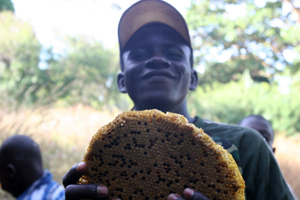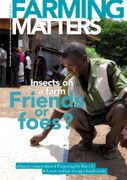Set up three years ago, the Zambia Honey Partnership (or ZHP) promotes the sustainable, social and economic growth of the country’s emerging honey industry. Known as “the platform”, it seeks to represent the interests of all stakeholders. By “enhancing their commercial orientation”, ZHP aims to help translate the production of honey into higher incomes for all those involved.

Beekeepers in the North-Western and Copperbelt provinces harvest an average of 10 hives each, and each hive yields about 10 kg per year. At current market prices, the sale of 100 kg can generate more than US$ 5,000 per year. These are very high returns – especially considering that the investment costs are minimal.
At the same time, however, a detailed analysis of the honey sector shows many difficulties, aside from yields and returns. These include a “non-commercial approach”, or the “lack of a clear strategy”. Studies in different regions have reported the possibility of hugely expanding the production areas. While producers lack information and short and longer-term finance options, market studies have shown that there is an unfulfilled demand in the local, regional and international markets.
Working together
The country’s honey sector has developed substantially since an umbrella body, the Zambia Honey Council (ZHC), was set up in 2003 with the mission of “developing the capacity of members through market development, technical innovation, information networks, policy advocacy, and through the promotion of ethics and standards in the honey industry”.
Membership has been open to beekeepers from different regions, many of whom have benefitted from the activities started by the Council: the organisation of training modules (in English and in local languages), the establishment of bulking centres in various honey-producing districts, and the dissemination of information via mobile phones.
In spite of the evident progress, a set of analyses carried out by organisations such as the Organic Producers and Processors Association of Zambia (OPPAZ) and the Agri- Business Forum (ABF) showed that a policy framework to govern and support the long-term development of the sector was still missing, and that the lack of co-ordinated efforts were seriously limiting growth. These studies showed that the positive results achieved at a local level could be scaled up with better links and co-ordination between all the different actors.
This led to a series of meetings between government agencies, non-governmental organisations (NGOs), business and trade associations, beekeepers, exporters/packers, researchers and international development agencies, all of whom joined the Zambia Honey Council in establishing the Zambia Honey Partnership (ZHP). ZHP was set up to address the constraints and opportunities in the honey industry – particularly by increasing the possibilities to work together.
Co-ordinated activities help farmers develop their capacities to produce honey and expand domestic production, and to improve profitability, by adding value to all products. Working together also offers the opportunity to scale up activities that support production and commercialisation (considering the necessary logistics, the provision of credit options and marketing).
The Partnership has put a set of strategic programmes in place. One of these is to target specific trade fairs; another organises beekeeper field exchanges. A special group is looking at the most important health issues affecting beekeeping and their potential implications, such as the trade barriers raised by South Africa (claiming there is evidence of the presence of American Foul Brood) or the incidence of what is known elsewhere as Colony Collapse Disorder. Neither problem has been detected, but regular monitoring is needed.
The Innovation Grants Facility (IGF) also deserves special mention: grants will be made available to beekeeper or producer associations or to processors wishing to develop or expand their post-harvest activities (such as processing, quality control or marketing efforts). Grants will be used to complement and support innovations, and will be assigned under a cost sharing arrangement. Applications have to go through a competitive process based on their project proposals.
Broad results
At the moment, the Zambia Honey Partnership is working in the three main honey producing provinces, with a total of 8 honey processors and more than 15,000 beekeepers. Although members recognise that there is still a lot to do, the quality of Zambian honey and packaging has already improved, and new marketing possibilities have been developed. This is visible, for example, in major retail shops such as Melissa and Spar, where different honey products are now sold. Larger quantities are also being exported to South Africa and Botswana, and even to the United Kingdom, Germany and the United States.
Mr Munshimbwe Chitalu, the ZHP Chairperson, proudly states that “Zambia has emerged as Africa’s largest exporter of honey and bee products to the European Union and the U.S., and the supply to these markets will exceed 1,000 tons by the end of 2012.” The industry is showing tremendous potential to help expand Zambia’s export base, foreign exchange reserves and, most importantly, broaden and deepen the income levels of the rural population.
It goes without saying that Zambian woodlands today resonate with two kinds of buzz. First is the hum from millions of bees gathering nectar from the surrounding dry forests. Second is the rising excitement among local villagers who see honey production as a rewarding and potential source of income.
Text: Nawa Mutumweno
Nawa Mutumweno (nawa_mutumweno@yahoo.com) works as Communications Consultant for the Zambia Honey Partnership, Lusaka.

